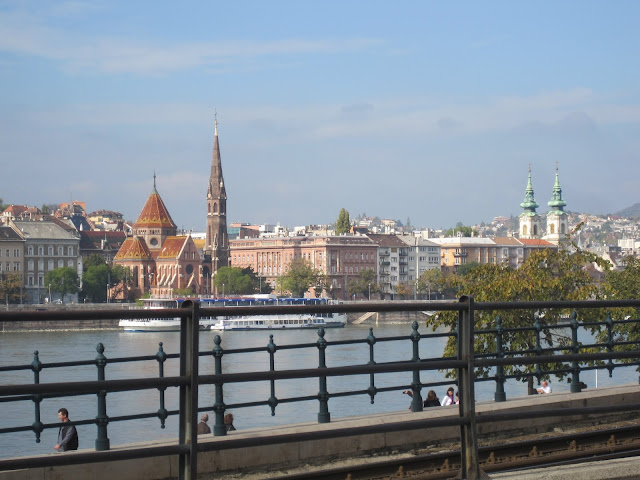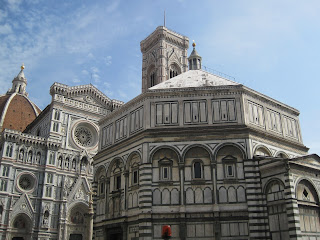Friday, October 12 - Saturday, October 13, 2012
On Thursday evening, October 11, my traveling group and I embarked on a
sixteen hour train journey from Capolago to Budapest. After a memorable
trip on a night train, preceded by an hour we spent by the water in
Zurich, we arrived in Budapest around 11:00 Friday morning.
 |
| Maverick Youth Hostel |
Budapest is a city divided by the Danube River, with Buda falling on the
West bank and Pest on the East side. With the exception of our walking
tour, we spent our time in Pest; however, my liking of Buda far exceeded
my liking of Pest. After departing the train, we headed for the ATM.
Budapest currency yielded the most astounding of currency exchange rates
at 1 US Dollar matching 222 Hungarian Florints. We used the currency to
pay for the best hostel we have stayed at to date: the Maverick Youth
Hostel.
 |
| The view of Buda from Pest |
 |
| Found my favorite part about fall in Pest! |
Once we settled in to our tree house style rooms, we headed in the
direction of the river. Our first glimpse of Buda, bridges, and the
surrounding old architecture was well worth the long wait of a sixteen
hour train ride. Standing near the Chain Bridge, we noted a nearby
building which though we didn't know what it was, prompted us to start
snapping our cameras. Then off to our stop, we realized that our
intended destination, the Great Hall Market, was what we had been taking
pictures of in minutes prior. Standing since 1896, Budapest's largest
market offered fish to fashion. The market was the first that we have
visited with two floors and consequently the market where we spent the
most time to date. I was quickly able to note things indigenous to
Budapest such as paprika and hidden key boxes. I also spotted my
favorite symbol of Autumn: pumpkins. However, every pumpkin price listed
was listed not as the sale price of a pumpkin, but instead was called
Halloween.
 |
| The Great Hall Market |
 |
| The largest market yet! |
By the time Friday night rolled around, I was more than thrilled to be
able to meet up with other Tech friends from another study abroad
program based in Italy. Michael Donovan and Matt Thomas introduced us to
members of their program, swapped stories with us, and joined us on a
pub crawl. Each of the four bars we went to were known as "ruin bars"
meaning that they were previously old buildings now converted into bars.
The artistic funk and uniqueness of each bar proved this true as I
noted different architectural aspects. At the fourth bar, the best
surprise of all was waiting for me... Lizzie! Though I knew she was
coming to Budapest, I didn't think I would see her until the following
day. After a great but brief reunion, I headed back to the hostel with
Dave and Ali. Our method of transportation back to the hostel
demonstrated just how touristy we were as Ali, Dave, and I were easily
duped into taking a taxi which ripped us off.
We decided to try out our first free tour on Saturday morning. Our tour
guide, Andrew, was energetic and full of trivia. Did you know that
Hollywood producers tend to choose Hungarian as the language of aliens
in movies? In fact, the way Yoda speaks is modeled off the Hungarian
language. "Backwards talk," like Yoda, and sentence structure such as
English speakers are used to are considered equivalent in the Hungarian
language; for example, saying, "Sausage I eat," or "I eat sausage," is
the same. Hungarian is an agglutinative language: small meanings form
large words. The language has 44
letters in it. This could help to contribute to the reason why the
language has a word which would be equivalent to a full sentence in
English that took Andrew approximately five seconds to say. The word, "megszentségteleníthetetlenségeskedéseitekért,"
means something like "for your continued behavior as if you could not
be desecrated.” If this seems complicated to you, you're not alone. The
Hungarian language is ranked in the top five hardest languages to learn.
However, the two most important words to know on our trip, "hello" was
coincidently translated to what sounds like "see ya" and "goodbye" to
"alo." He joked that when we walk into shops, uninterested shopkeepers
may great us with "alo," in hopes of us leaving.
 |
| Matthias Church |
As we stood listening to Andrew by the river running through Hungary's
coastal, he noted a statue that is known as Szabadsag Szobor or Statue
of Liberty. The statue was built after World War II, in 1947, to
memorialize Hungarian freedom. However, Hungary is only a more recent
post-Communist country. Moreover, the older generation struggles with
more modern thought like ours and Andrew's generation. Following our
observing of the Danube and its surrounding landscape, we walked across
the Chain Bridge, up a lot of steps, and arrived in the Buda Castle
District. The views from this point were beautiful. In our time in the
castle district, we saw Fisherman’s Bastion, Matthias Church and the
Royal Palace and Buda Castle, both UNESCO World Heritage sites.
Unfortunately, we were unable to go into any of these sites. Matthias
Church's exterior was so pretty and colorful. Though known as the name
of a Hungarian king, the church is officially titled The Church of Our
Lady.
 |
| The Chain Bridge |
Budapest was equally as beautiful in the daytime as it was at night.
Determined to burn the candle at both ends before boarding our sixteen
hour train at 6:00 Sunday morning, Lizzie met up with us at our hostel
and we headed out to what was voted the number one bar in the world by
Lonely Planet
The bar, was an old Ukrainian ship docked on the Buda side of the river.
We enjoyed different bar locations throughout the ship where we were
able to socialize and for a second night in a row, try a different fruit
flavor of the traditional Hungarian alcohol, Pálinka. A very strong
liquor, it dates back 500 years to when it was used more as a digestive
medicine. As the club started to fill up, DJ A.Skillz took the stage
near the large dance floor and we began imitating some of the many
European style dance moves. The environment was so much fun that we lost
track of time until we decided it was time to leave at 3:00. And then
came the best trip to Doner Kebab of the trip... I didn't know it was
possible. Kacey, Ali, and I thought it would be easier to just keep
staying awake since we had to leave for the train station at 5:00 so in
turn we were rewarded for our stamina by our discovery of arguable the
best hummus EVER! However my favorable opinion of this particular dip
most likely had something to do with the fact that I've been deprived of
my favorite snack since August. We then made it back to the hostel and
attempted to stay awake. The plan worked well until I heard everyone
else's alarms going off and then I promptly fell asleep for half an hour
until someone woke me up and told me we were leaving... so much for
avoiding the brutal wakeup call.
 |
| Budapest! |



























